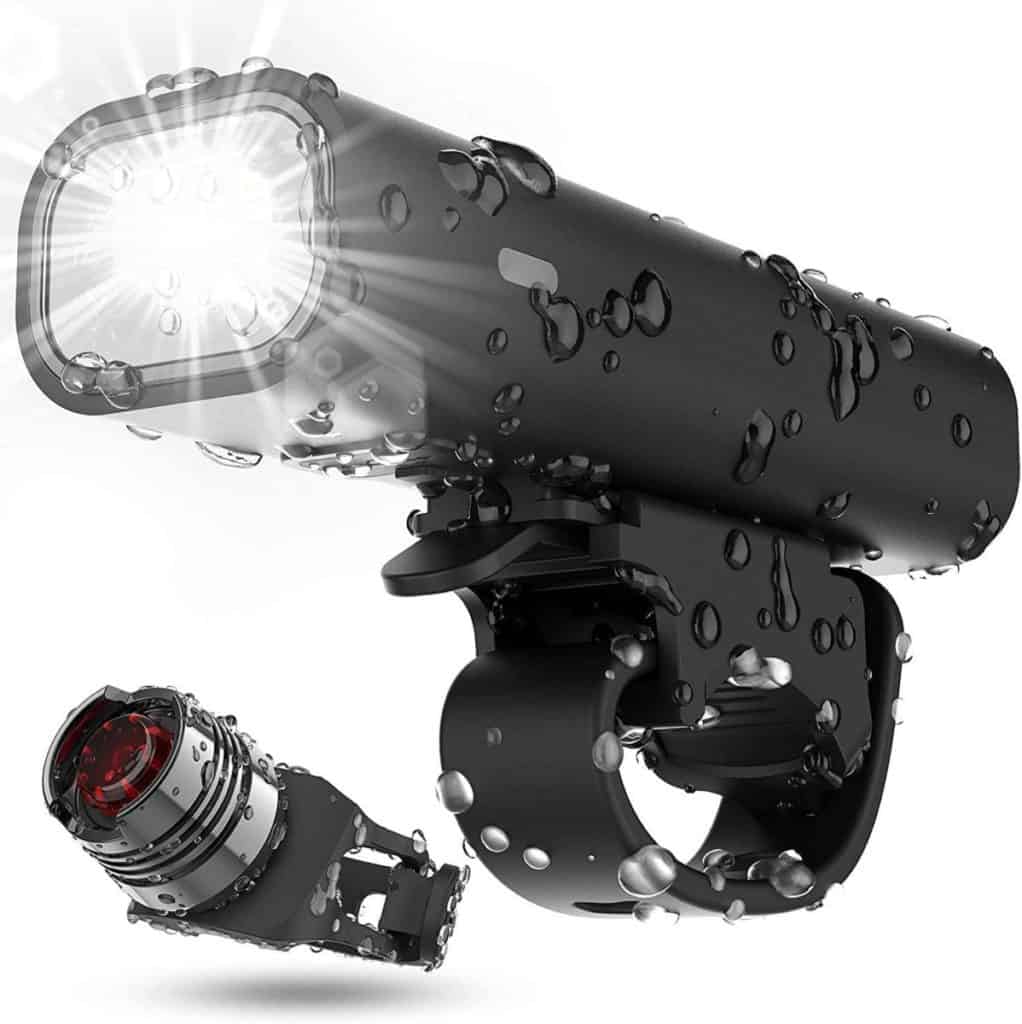
When it comes down to selecting the ideal bike for your daily commute, there are several characteristics to take into considerations. However, you might be able to make the most out of the mountain bike that is already in your garage. Of course, with the right modification.
Commuting on a mountain bike is possible, and can offer better road safety levels when riding on wet surfaces or off-road. Differences with regular road bikes include wheel width, riding position, and weight. By adding lights, mudguards, and racks to a mountain bike, you can commute on it.
Read all about how to get your mountain bike ready for your upcoming commute below.
Differences Between Road and Mountain Bike for Commuting
As we have seen, commuting on a mountain bike is possible. However, if you have been riding a road bike or utility bike, there are some differences you can’t underestimate. By understanding such variations, you can then modify your mountain bike to achieve better comfort and safety on the road.
Characteristics of Road Bikes
Road bikes – as well as utility bikes – are bicycles that are ideal for commuting. They are designed to carry some luggage at the back and improve speed on paved roads. Due to the decreased wheel width, they don’t provide much adhesion to the concrete, but they can get you to your office much faster than mountain bikes would.
Here are some of the features that define a road bike:
- Lightweight
This characteristic makes them easy to move around, park, and pick up. Moreover, for riders that have just started experimenting on their bikes, these are the perfect options. Indeed, they require much less energy and effort to reach a satisfying speed.
- Narrow tires
The narrow tires mounted on these bikes are what makes them so fast on paved roads. The reduced width reduces adhesion to concrete and rolling resistance. This characteristic allows you to pedal much faster and with less effort. There are downsides to this feature that we will explore below.
- Fast on paved roads
On paved or urban roads, these bikes can help you ride faster without much sweating. However, they are not suitable for off-road paths.
- Drop handlebar
This characteristic makes road bikes comfortable to hold and ride. However, you might not be able to achieve the same level of control that a flat handlebar (like the one on mountain bikes) can offer.
- Forward-leaning riding position position
Road bikes are all about aerodynamics. The forward-leaning position you will assume while riding allows you to create less resistance, which can help you go faster when cycling. However, this can decrease the level of comfort on your bike if you are riding for prolonged time frames.
Characteristics of Mountain Bikes
Mountain bikes are a much more recent addition to the vast array of bikes that are today on the market. These are designed to offer riders better control over uneven terrains, but they might sacrifice speed and comfort.
Some characteristics of mountain bike include:
- Heavier
With a larger, more substantial drive train and wheels, this type of bike can suddenly become bulky. At least more so than standard road bikes.
- Flat handlebars
The flat handlebar this bike boasts is perfect to have optimal control over the terrain and road. However, this can add a strain to your arms and might add fatigue to your commute.
- Thicker tires
The tires of a mountain bike are potentially the most apparent difference between the two. These tires are often 27.5 or 29 inches in diameter, as opposed to the larger, but thinner, 700C road bicycle wheels. Moreover, such tires are knobby, which increases traction and adhesion to the road for better control.

Mountain Bike Modifications for Commuting
Once you have considered all these characteristics, mountain bikes are among the best choices for bike commuting unless you wish to invest in an apposite bike for your type of commute. However, if you already have a mountain bike you want to put to use, you will be pleased to know that, with some modifications, it can get you to your office and back without issues.
It is essential to understand that you might need to adapt to the new riding style, and there are downsides that you need to take into consideration to avoid dangerous situations on the road. Let’s have a look at what modifications you need to make before riding to work.
Add Mudguards Above the Wheels

When riding your mountain bike up and down mountains paths and trails, you might not have to worry much about being splashed or getting dirty. Or, at least, you would be prepared for this downside of the sport.
Indeed, only a few models of mountain bikes come complete with fenders. This is mainly because on muddy terrains the quantity of mud that could end up stuck between the fenders and the tires could prevent yours from riding smoothly.
However, when it comes down to riding to work during a rainy day, the large wheels of your mountain bike can send splashes and mud up to your clothes.
This can not only make the commute less enjoyable, but you might have to invest in a series of additions to your equipment to look smart after your ride. Another viable solution is to add mudguards to the front and rear bike.
These additions are inexpensive and highly accessible. They can be mounted at home with just a few tools, without the need to ask for the help of a technician or mechanic.
Additionally, you can invest in a type of mudguard, like the ultra-modern YBLNTEK Mudguard, which are retractable. So you won’t have to put them on and take them off depending on the weather, and you have an extra layer of protection at your disposal any time you need.
Change the Tires
As we have seen, mountain bikes are characterised by thick, knobby tires that allow the rider to enjoy a much higher adhesion to the road and better control over the bike. However, these can become very cumbersome on a well-paved street or smooth track.
Additionally, tick tires can increase the weight and render the manoeuvrability of your bike much more troublesome. So, you should start your adjustments to ride such a bike to work by replacing the tires.
While the pre-existent structure of the wheel might not allow you to mount extremely thin or lightweight tires, you can substitute your heavy off-road tires with narrower tires that are less knobby.
When mounting such slicker tires on the rims, you will notice the impact of this adjustment on the bike’s feel, weight, and speed. However, alongside the tires, make sure you are investing in appropriate tubes that are puncture-proof. If you are not sure what the best type is, speaking to a bike mechanic or expert can help.
Adjust the Tires’ Pressure
Another factor that can significantly impact your experience while riding is the tire’s pressure. The perfect bike tires’ pressure ultimately depends on your weight, the bike’s weight, and rolling resistance. This refers to the traction and adhesion to the concrete or soil.
When you are pumping the tires to the maximum pressure, this can lower the rolling resistance, making your bike more aerodynamic, and therefore, faster. Finding the perfect pressure level is essential to improve your performance, stay safe on the road, go faster, and avoid punctures. Ultimately, this can help you look after your bike’s tires and drivetrain.
Thicker tires already provide a higher level of adhesion with the floor, due to the larger width and contact surface. However, slightly lowering the pressure by 10 or 5 psi increases your level of safety during wet weather conditions.
On the other hand, pumping the tires to higher pressures decreases the rolling resistance. In turn, in dry weather conditions, this allows you to ride much faster and smoother. Indeed, as the rolling resistance decreases, you will have to fight less traction.
Invest in Front and Rear Lights

When it comes down to visibility devices, your mountain bike might not boast all the equipment you are required to have. When looking at the UK regulations that define the requirements for urban riders, you should make sure that your bike is equipped with:
- Reflectors at the rear of the bicycle – must be red or orange
- Reflectors mounted on the front and rear side of each pedal – must be amber or orange
- White front light – mandatory to cycle in situations of poor visibility or after sunset
- Red rear light – necessary to cycle in conditions of poor visibility or after sunset
You should notice that the law does not state that all those features should be mounted on the bike before the sale. Therefore, it is your responsibility as a cyclist to make sure that such additions are incorporated. And, you should do so before jumping on your saddle!
Add Reflective Tape or Items
Aside from the lights that you have added to your bike, you should make sure your vehicle boasts the right number of reflectors, both at the front and rear of your bike. In this case, the colour of such additions is essential – should be white at the front and red at the back.
Once your mountain bike is ready for the urban roads, don’t forget that you can increase your visibility by adding other items to your cycling equipment. Additional visibility devices that you should consider adding are:
- Helmets with integrated lighting system – make sure it complies with light regulations, and it does not dazzle other road users
- Reflector bands around your cuffs
- Reflective vest
- A bike bell
- A reflective rain jacket
Install a Rack or Carrier
Unlike utility bikes and specific road bikes, mountain bikes seldom come furnished with a rear rack. While you might not have much luggage with you when riding in mountain paths and tracks, you will need a place to keep your laptop bag safe while on the road. Installing a rack is the most economical and affordable solution to this issue.
You can either find a custom made one or opt for a generic model that will allow you to store your gear either on the sides of the wheels or just behind your saddle. You can learn more about how to pack your equipment in the video below:
Swap the Pedals
This is not an adjustment that all mountain bikes’ owners will have to make. However, if the pedals of your bicycle are only suitable for professional footwear, you might not be able to commute with your usual gear. Instead, swap to flat or clipless pedals for better control. This can also help you take your feet off the pedals any time you have to stop at a red light!
Challenges of Commuting With a Mountain Bike
So, it is possible to commute on a mountain bike. The adjustments that you will have to make are limited and inexpensive. Overall, this is an excellent solution if you do not wish to invest in a brand new bike to use only during your commutes.
However, there still are some pros and cons that you might need to consider before sticking to your decision. Here is an overview of a few factors that can guide you in your choice.
Consider the Type of Terrain
Not all commutes are the same. This factor can be the most influential one in deciding whether your mountain bike is indeed suitable for this type of ride. If you are commuting for less than 15 minutes each way and the road is flat and well-paved, any bike (including MTBs) will do the job.
However, if you are looking at crossing several different kinds of terrain or locations, it is essential to find the right type of tires that can guarantee you a comfortable level of safety on the road. Generally speaking, mountain bikes are suitable for most types of terrain.
Consider Comfort Levels
Road bikes, as well as utility bikes, offer the comfort you need to ride for extended time frames. However, when it comes down to mountain bikes, the saddle and riding position is designed for you to control your bike over uneven terrain.
In many cases, mountain bikers tend to not sit on the saddle at all! While it won’t take you long to adjust to the new position, you might consider swapping the current saddle for a more comfortable seat that allows you to enjoy your commute more.
They Can Be Slower on Urban Roads
As we have seen, the large, wide tires of a mountain bike can help you enjoy a higher level of safety on the road, especially in wet-weather conditions. However, by increasing the level of rolling resistance and adhesion, they will impact your performance.
Ultimately, if you have been using a road bike for a while, you might consider leaving your house a little earlier, at least the first time. These tests allow you to gauge an understanding of how long it will take you to cover the same distance on a heavier mountain bike. These adjustments are only necessary until you increase your fitness level or you become used to the extra weight.
Benefits of Commuting With a Mountain Bike
While the downsides of picking a mountain bike should be considered, it is undeniable that there are some appealing benefits to it! Of course, the most apparent one is that you won’t have to invest in a new bike just for your commute and you can make the most out of your mountain bike. However, some other advantages might be less distinct.
Large Tires Are Safer on Wet Concrete
Firstly, if you are riding in the UK, you will know that the weather, especially in winter or autumn, rarely blesses cyclists with sunny morning or afternoons. In this case, the thin tires that are mounted on road bikes can decrease the level of safety on the road and even become a hazard if they are not adequately pumped and maintained.
Oppositely, the knobby, large tires of mountain bikes allow you to enjoy a better adhesion to the floor, even if this is wet.
Better Balance on the Road Due to Large Tires
If you have decided not to invest in a rack or carrier, you might be stuck with a messenger bag or backpack to balance on your back during your ride. While this is something commuters rapidly get used to, an extra height on your back can threaten your balance and make it more challenging to ride effortlessly.
The large tires of a mountain bike and the stockier structure are perfect to increase your sense of balance while travelling through traffic and urban roads.
You Can Shorten Your Commute Through Shortcuts
Lastly, mountain bikes are designed for cyclists to enjoy off-road terrain and tracks. While they cope well with well-paved roads and urban streets, there is no reason why you would not consider trying out a new shortcut.
Uneven short cuts and paths that you could not access with a standard road bike might suddenly become obvious choices to shorten your ride to work.
Conclusion
If you already have a mountain bike and you wish to use it for your commute, you are making an optimal choice. Such bikes are designed to withstand any type of terrain and provide you with a high level of safety and balance.
However, since mountain bikers are primarily concerned with balance and challenging tracks, you might notice a decrease in performances and speed. This is mainly due to the large tires, and higher weight of the bike’s structure. Nonetheless, deciding to leave your home earlier during your first couple of rides can help you tackle this issue.
Sources
- Science of Cycling: Tension not Compression
- University of Pretoria: Comparison Of Tyre Rolling Resistance For Different Mountain Bike Type Diameters and Surface Conditions
- Wikipedia: Rolling resistance
- Cycling Weekly: What’s the correct road bike tyre pressure?
- Legislation.gov.uk: The Road Vehicles Lighting Regulations 1989
- Accident Analysis and prevention Journal: Visibility aids for pedestrians and cyclists: a systematic review of randomised controlled trials
- SJS Cycles: UK Bicycle Lighting Law

